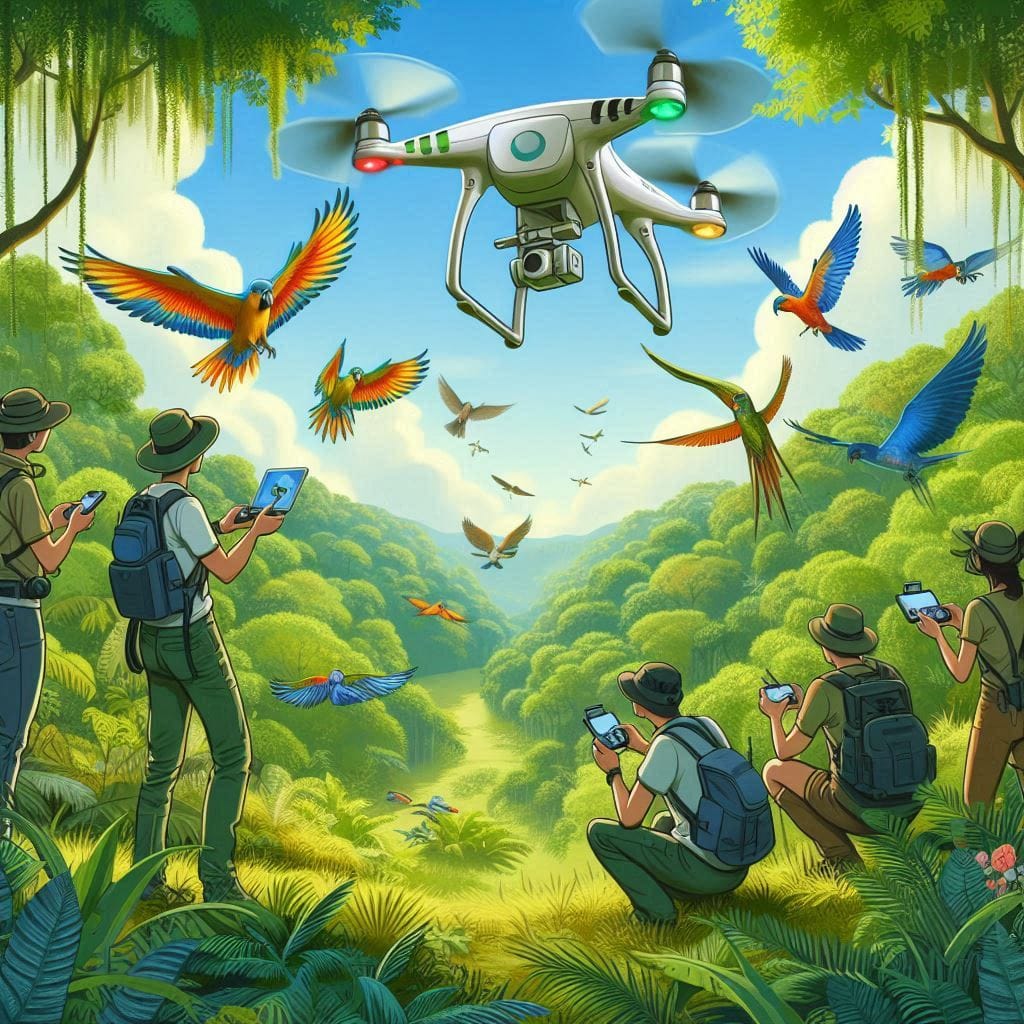Wildlife Conservation In The Age Of AI: Opportunities And Threats

Table of Contents
AI-Powered Tools Enhancing Wildlife Conservation Efforts
AI is rapidly transforming wildlife conservation practices, providing powerful tools for more efficient and effective interventions. These tools are revolutionizing how we monitor, understand, and protect vulnerable species and their habitats.
Improved Monitoring and Surveillance
AI-powered monitoring is significantly improving our ability to track and understand wildlife populations. This is achieved through several key applications:
- AI-powered drones: Drones equipped with advanced sensors and AI-driven image analysis can cover vast areas efficiently, providing real-time data on habitat conditions and wildlife activity. This allows for quicker identification of threats like habitat loss or poaching.
- Smart camera traps: AI algorithms can analyze images from camera traps, automatically identifying and classifying different species, reducing the time and resources required for manual review. This allows for more accurate population estimations and detailed behavioral studies.
- Population monitoring: AI can analyze data from multiple sources, including camera traps, GPS tracking collars, and acoustic sensors, to build comprehensive models of wildlife populations, providing critical insights into population dynamics, migration patterns, and habitat use. This facilitates targeted conservation strategies.
- Poaching detection: AI algorithms can analyze acoustic data to detect gunshots or other sounds associated with poaching activities, enabling rapid response and potentially preventing illegal hunting. This is a crucial step towards combating wildlife crime.
- Predictive habitat mapping: By combining AI with remote sensing data (satellite imagery, LiDAR), we can create detailed predictive habitat suitability models, identifying crucial areas for conservation and guiding land-use planning decisions. This aids in the proactive protection of crucial wildlife habitats.
Predictive Modeling for Conservation Strategies
AI's predictive capabilities are invaluable for developing effective conservation strategies. By analyzing vast datasets, AI models can anticipate future challenges and optimize interventions:
- Climate change impact prediction: AI can analyze climate data and species distribution models to predict how climate change will affect wildlife populations and habitats, informing proactive mitigation strategies. This allows for preemptive conservation efforts, ensuring the survival of vulnerable species.
- Disease prediction and spread: AI can analyze epidemiological data to predict the outbreak and spread of diseases within wildlife populations, facilitating early interventions and disease management. This is crucial in preventing mass mortality events in sensitive species.
- Optimization of conservation interventions: Machine learning algorithms can analyze the outcomes of various conservation strategies (e.g., habitat restoration, anti-poaching patrols) to optimize resource allocation and maximize their impact. This ensures that conservation efforts are as efficient as possible.
- Scenario planning: AI can simulate different future scenarios (e.g., varying levels of climate change, different management strategies) to assess their impact on wildlife populations and guide decision-making. This aids in making informed choices for long-term conservation planning.
Challenges and Ethical Considerations of AI in Wildlife Conservation
While AI offers immense potential, its application in wildlife conservation is not without challenges and ethical considerations.
Data Bias and Algorithmic Fairness
The accuracy and fairness of AI models heavily depend on the quality and representativeness of training data. Biases in data can lead to inaccurate predictions and perpetuate existing inequalities:
- Addressing data bias: It’s crucial to ensure that training datasets are diverse, representative, and free from human biases. This requires careful data collection and curation practices.
- Algorithmic transparency: Understanding how AI algorithms arrive at their conclusions is vital to build trust and identify potential biases. This requires transparent and explainable AI systems.
- Ensuring fair outcomes: The application of AI should ensure equitable outcomes for all species and stakeholders, avoiding the exacerbation of existing environmental injustices.
Privacy Concerns and Data Security
The use of AI for wildlife monitoring raises important privacy concerns, particularly regarding the tracking and surveillance of individual animals:
- Robust data security: Strong data security protocols are essential to protect sensitive wildlife data from unauthorized access and misuse. This requires implementing robust cybersecurity measures and careful data governance.
- Data anonymization: Techniques for anonymizing data should be employed to protect the privacy of individual animals and reduce the risk of misuse.
- Ethical guidelines: Clear ethical guidelines for the use of AI in wildlife monitoring are crucial to ensure responsible and transparent practices.
Technological Accessibility and Affordability
The benefits of AI-powered conservation tools should be accessible to all, regardless of location or resources:
- Affordable AI solutions: Developing cost-effective AI tools and technologies is essential to ensure that organizations and communities in developing countries can benefit from their use.
- Capacity building: Providing training and support to local communities and organizations is crucial to enable them to effectively utilize AI-powered conservation tools.
- Open-source software: Sharing open-source AI tools and algorithms can foster collaboration and make them more widely accessible.
The Future of AI in Wildlife Conservation
The future of wildlife conservation is inextricably linked to the responsible development and deployment of AI. AI has the potential to revolutionize conservation efforts:
- Advancements in genomics and environmental DNA (eDNA): AI is accelerating progress in genomics and eDNA analysis, allowing for faster and more accurate species identification and population monitoring. This allows for a deeper understanding of biodiversity and genetic diversity.
- Citizen science initiatives: AI can empower citizen science projects by enabling broader participation and automated data analysis, leading to more comprehensive wildlife monitoring efforts. This harnesses the collective power of individuals to contribute to conservation.
- Improved habitat restoration: AI can optimize habitat restoration efforts by identifying priority areas and predicting the effectiveness of different restoration techniques. This enables efficient use of resources to restore critical wildlife habitats.
Conclusion:
AI presents a double-edged sword for wildlife conservation. While it offers powerful tools for enhanced monitoring, predictive modeling, and optimized strategies, ethical concerns regarding data bias, privacy, and accessibility must be addressed. The responsible development and implementation of AI-powered solutions are crucial for maximizing its benefits while mitigating potential risks. We must embrace the potential of AI for wildlife conservation while mitigating its risks. Learn more and get involved in responsible AI for wildlife conservation today! Support organizations dedicated to developing and implementing ethical AI-powered solutions for protecting endangered species and preserving biodiversity. Let's work together to ensure that AI serves as a powerful ally in the fight for wildlife conservation.

Featured Posts
-
 Neuer Bvb Star Adeyemi Mit Elegantem Stil
Apr 23, 2025
Neuer Bvb Star Adeyemi Mit Elegantem Stil
Apr 23, 2025 -
 Blockchain Analytics Leader Chainalysis Integrates Ai Through Alterya Purchase
Apr 23, 2025
Blockchain Analytics Leader Chainalysis Integrates Ai Through Alterya Purchase
Apr 23, 2025 -
 10 Cardinals Likely To Be Considered In The Next Papal Conclave
Apr 23, 2025
10 Cardinals Likely To Be Considered In The Next Papal Conclave
Apr 23, 2025 -
 Detroit Tigers Drop Series To Milwaukee Brewers 5 1
Apr 23, 2025
Detroit Tigers Drop Series To Milwaukee Brewers 5 1
Apr 23, 2025 -
 Power Outage Updates Lehigh Valley Battling High Winds And Storm Damage
Apr 23, 2025
Power Outage Updates Lehigh Valley Battling High Winds And Storm Damage
Apr 23, 2025
